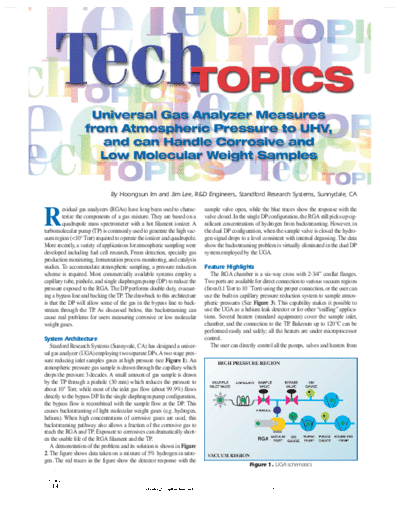Service Manuals, User Guides, Schematic Diagrams or docs for : Stanford Research Systems www.thinksrs.com-vtc_UGAarticle
<< Back | HomeMost service manuals and schematics are PDF files, so You will need Adobre Acrobat Reader to view : Acrobat Download Some of the files are DjVu format. Readers and resources available here : DjVu Resources
For the compressed files, most common are zip and rar. Please, extract files with Your favorite compression software ( WinZip, WinRAR ... ) before viewing. If a document has multiple parts, You should download all, before extracting.
Good luck. Repair on Your own risk. Make sure You know what You are doing.
Image preview - the first page of the document

>> Download www.thinksrs.com-vtc_UGAarticle documenatation <<
Text preview - extract from the document
By Hoongsun Im and Jim Lee, R&D Engineers, Standford Research Systems, Sunnydale, CA
sample valve open, while the blue traces show the response with the
R
esidual gas analyzers (RGAs) have long been used to charac-
terize the components of a gas mixture. They are based on a valve closed. In the single DP configuration, the RGA still picks up sig-
quadrupole mass spectrometer with a hot filament ionizer. A nificant concentrations of hydrogen from backstreaming. However, in
turbomolecular pump (TP) is commonly used to generate the high vac- the dual DP configuration, when the sample valve is closed the hydro-
uum region (<10-5 Torr) required to operate the ionizer and quadrupole. gen signal drops to a level consistent with internal degassing. The data
More recently, a variety of applications for atmospheric sampling were show the backstreaming problem is virtually eliminated in the dual DP
developed including fuel cell research, Freon detection, specialty gas system employed by the UGA.
production monitoring, fermentation process monitoring, and catalysis
studies. To accommodate atmospheric sampling, a pressure reduction Feature Highlights
scheme is required. Most commercially available systems employ a The RGA chamber is a six-way cross with 2-3/4" conflat flanges.
capillary tube, pinhole, and single diaphragm pump (DP) to reduce the Two ports are available for direct connection to various vacuum regions
pressure exposed to the RGA. The DP performs double duty, evacuat- (from 0.1 Torr to 10 -7 Torr) using the proper connection, or the user can
ing a bypass line and backing the TP. The drawback to this architecture use the built-in capillary pressure reduction system to sample atmos-
is that the DP will allow some of the gas in the bypass line to back- pheric pressures (See Figure 3). This capability makes it possible to
stream through the TP. As discussed below, this backstreaming can use the UGA as a helium leak detector or for other "sniffing" applica-
cause real problems for users measuring corrosive or low molecular tions. Several heaters (standard equipment) cover the sample inlet,
weight gases. chamber, and the connection to the TP. Bakeouts up to 120◦ Jabse Service Manual Search 2025 ◦ Jabse Pravopis ◦ onTap.bg ◦ Other service manual resources online : Fixya ◦ eServiceinfo